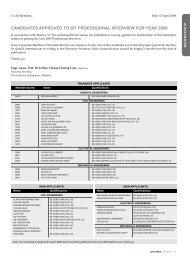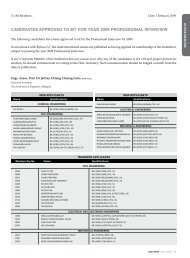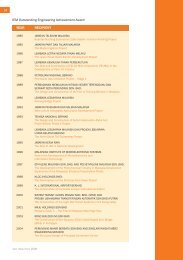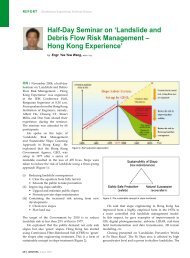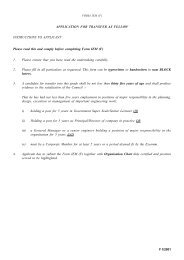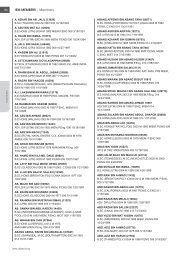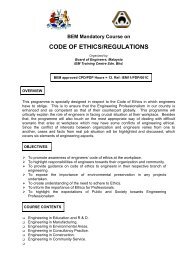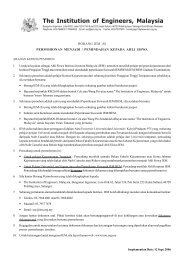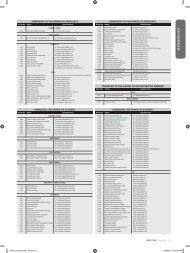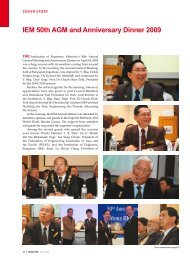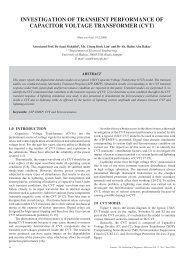methyl methacrylate case study
methyl methacrylate case study
methyl methacrylate case study
Create successful ePaper yourself
Turn your PDF publications into a flip-book with our unique Google optimized e-Paper software.
Screening alternative chemical routes based oninherent chemical process properties data:Methyl <strong>methacrylate</strong> <strong>case</strong> <strong>study</strong>(Date received: 7.4.2009)Mimi H. Hassim 1,2 and Mohamad W. Ali 11Universiti Teknologi Malaysia,Department of Chemical Engineering, 81310 UTM, Skudai, Johor Darul Takzim2Helsinki University of Technology,Department of Biotechnology and Chemical Technology, 02015HUT, FinlandE-mail: mimi@cc.hut.fi and mharyani@gmail.comabstractIn 1988 a campaign called Responsible Care was initiated as a response to the adverse publicity of the Bhopal disaster.The initiative commits chemical industries to improve safety, health, and environmental (SHE) performance. Inherentsafety concept can be incorporated at any stage of process lifecycle. However, the best results will only be achieved if itis implemented during the initial research and development (R&D) phase, when chemists and engineers are consideringdifferent choices of process alternatives, besides making fundamental and yet critical decisions such as type of raw materialsand operating conditions to be used throughout the process. Process hazards assessment during conceptual stage is importantsince degree of freedom for making changes is still high and the associated cost is low. Besides inherent safety features can beadopted most effectively. Alternative process routes screening during the R&D stage involves the assessment of huge numberof chemical routes - sometimes there can be up to hundreds of them. However, time and information available at this pointare very limited; thus simple and swift approaches are highly in demand. This paper presents the methods for evaluatingSHE performance of chemical processes based on inherent chemical and process properties. To ensure their practicalityand applicability, the methods require data which is readily acquired from Material Safety Data Sheet (MSDS) and processreaction chemistry. The methods are applied on six <strong>methyl</strong> <strong>methacrylate</strong> (MMA) manufacturing routes. The results show thatthe isobutylene based route (i-C4) is the best process from inherent safety aspect and the ethylene via <strong>methyl</strong> propionatebased route (C2/MP) is the best one from inherent health and environmental criteria. Finally, multi-criteria decision-makingtool is applied to select a route with the optimised SHE benigness level. Based on the <strong>study</strong>, the C2/MP is regarded as thebest route with the optimum performances in the SHE aspects. The <strong>case</strong> <strong>study</strong> analysis shows that the methods are capableof comparing different design concepts by their individual S, H, E criteria as well as the optimised SHE aspect altogethereffectively.Keywords: Hazard Evaluation; Process Design; Process Development; Reaction Chemistry; Route Selection1.0 INTRODUCTIONNowadays, sustainability has become the core concept whendefining desired long-lasting state. Sustainability is often definedas ‘meeting the needs of the present without compromising theability of future generations to meet their own need’ [1]. EU hasadopted sustainable development as one of its central objectives.IPPC and REACH are among the EU directives that demandsafety, health, and environmental (SHE) aspects to be takeninto consideration in earlier phase of process development anddesign.The inherent safety concept professes that potential processhazards should be identified as early as possible – ideally whenthe process is still ‘on paper’ [2]. Inherently safer design (ISD)is an approach that focuses on elimination or reduction of hazardfrom a process. Unlike extrinsic safety which depends on addonsystem, procedure/management, and human intervention tocontrol or manage hazard, intrinsic safety deals with the processproperty itself – thus the safer characteristic of the process ispermanent and inseparable.Generally, inherent safety property depends on thechemicals and operating conditions of a process. These twocritical decisions are made at the very early stage of researchand development (R&D) based on a limited amount of processinformation. At this stage, the feasibility of a number of chemicalprocess routes is studied. Chemical process route can be definedas the raw material(s) and the sequence of reaction steps thatconverts them to the desired product(s) [3]. Economic used to bethe decisive criteria in process route selection [3]. Route that isanalyzed to be the most profitable during early process screeninghas often been chosen as the one to be considered for processdevelopment. However, the paradigm has gradually changedtowards better appreciation of process performance in SHEaspects. The challenge is how to evaluate the aspects during theR&D stage when the only process-related information available2Journal - The Institution of Engineers, Malaysia (Vol. 70, No.4, December 2009)002-010•Screening alternative chemical 4pp.indd 21/21/2010 9:38:02 AM
Screening alternative chemical routes based on inherent chemical process properties data: Methyl <strong>methacrylate</strong> <strong>case</strong> <strong>study</strong>is the reaction chemistry pathway.This paper proposes a simple approach to assess chemicalhazards from safety, health, and environmental perspectivesat inherent level. Many engineers do not realise that inherentlevel <strong>study</strong> is fundamental to the industrial practice of chemicalengineering and applied chemistry because it relies on theunderlying chemistry and physics of the materials, chemicaltransformations, and molecular separations involved in chemicalprocessing [4]. This paper aims to highlight the significanceof basic knowledge on chemistry in determining the inherenthazard of a chemical process. Early process evaluation willhelp engineers in making sound selection of reaction chemistrypathway to be developed, which will have major impacts on laterperformances (e.g. construction, operation, decommissioning) ofthe process.2.0 CHEMICAL ROUTES SCREENING BASEDON INHERENT HAZARD ASSESSMENTResearch and development is a stage where the chemicalsynthesis route is selected. The process designer has the greatestopportunity to incorporate inherent safety principles, since majordecisions are mainly done in this stage [5]. Various methodshave been developed for assessing inherent safety, health, andenvironmental friendliness of chemical synthesis routes. Due totime and information constraints, majority of the methods weredeveloped as index-based. For R&D stage assessment, the indexmust be simple, swift, and transparent, such that it can be easilyapplied. Most importantly, the index must require only datawhich is readily available at this stage.Since a process lifecycle starts with R&D, no data aboutthe process is yet available. Once the target product hasalready been chosen, the only process information that can beobtained is reaction chemistry pathway from literature, such asencyclopedias, patents, journals, and etc. Reaction chemistryprovides brief information about the chemicals involved in theprocess as well as operating conditions, typically reaction phase,temperature, pressure, and yield, which govern the developmentof the indexes. The earlier version of the indexes relies solely onthis information; while the later version involves more detailedworks and calculations - intending to produce more reliable andcomprehensive assessments.2.1 Existing MethodsVarious indexes are available for inherent SHE evaluationof chemical processes throughout process development anddesign phase. Some were developed for the R&D stage with theaim and scope of application as previously described. Some ofthe methods evolve to a later stage of preliminary design, basicengineering, and detailed design, depending on their extent ofresearch interest. Nonetheless, all of them share the same objectiveof assessing the inherent hazard of a process before constructionphase begins. The later the assessment is performed, the cost ofmaking changes becomes more expensive and the opportunity tointegrate process with ISD features gets smaller [5].Among safety, health, and environment criteria, methodsfor inherent safety assessment are the most well researched andwidely available. Several of the methods that can be mentionedhere are the Prototype Inherent Safety Index; PIIS [3], InherentSafety Index; ISI [6], Hazard Identification and Ranking; HIRA[7], Rapid Risk Analysis Based Design; RRABD [8], SafetyWeighted Hazard Index; SweHI [9], Simple Graphical Method[10], and i-Safe [11]. On top of the assorted methods, expertjudgment and point of view about this subject is also available[12].For evaluating inherent environmental hazard of chemicalprocess, various methods have been proposed, namely theEnvironmental Hazard Index; EHI [13], Waste ReductionAlgorithm; WAR [14], Atmospheric Hazard Index; AHI [15],Global Environmental Risk Assessment Index; GERA [16],Inherent Environmental Toxicity Hazard; IETH [17], andEnvironmental Consequence Index; ECI [18].Compared to safety and environment, health is the leastdiscussed and researched process characteristic at inherent level.Studies on the development of indexes for an exclusive inherenthealth assessment of chemical process routes are relatively new.Among the existing methods are the Occupational Health HazardIndex; OHHI [19], Process Route Healthiness Index; PRHI [20],Inherent Occupational Health Index; IOHI [21-22], Health Index;HI [23], and Occupational Health Index; OHI [24].Several comparisons of the index methods have also beenpublished [25] mainly for inherent safety methods [26-28].Environmental and health methods were compared by Hertwichet al. [29] and Koller et al. [30]. The latest one was by Adu etal. [31] who made a comprehensive comparison of methods forassessing safety, health, and environmental hazards.3.0 CHEMICAL PROCESSES SCREENINGBASED ON CHEMISTRY DATAThe objective of this paper is to demonstrate how achemical process route can be assessed in the R&D stage for itssafety, health, and environmental hazard based on the chemistrydata. A quick but sound approach is in need since a high numberof alternative routes have to be evaluated within a limitedtime.Two types of data can be acquired from reaction chemistry:1) chemical substances and 2) process conditions. This paperfocuses on the first data, which is the hazard potentially posed bychemical substances. Although for a chemical process, potentialhazard is a function of both the chemical and the process, thispaper aims to look at the inherent characteristics of processconcepts merely from the chemical substances standpoint.Thorough understanding about chemical hazard is criticalespecially at the R&D stage since the upmost principle of ISD iselimination. Ideally, hazardous chemical should be eliminated sothat the hazard and potential risk can be totally avoided. However,in most <strong>case</strong>s eliminating chemical substance from a process isnot possible; therefore substitution should be opted as the nextprinciple. Substituting a chemical with a less hazardous one, butposing an equivalent functional property requires adequate dataon chemical hazard.Therefore, here an approach to evaluate inherent SHEhazard of chemical process routes based on the chemical hazarddata is proposed. To ensure its simplicity and wide applicability,the approach requires only those data that are readily availablefrom Material Safety Data Sheets (MSDSs) or InternationalChemical Safety Cards (ICSCs) or other source of similar data.The existing inherent SHE indexes were studied in terms of theirbasic principles and parameters used for evaluating the processproperties. In inherent safety, parameter types are relativelywell established [25], but health and environmental criteria haveJournal - The Institution of Engineers, Malaysia (Vol. 70, No.4, December 2009) 3002-010•Screening alternative chemical 4pp.indd 31/21/2010 9:38:02 AM
Mimi H. Hassim, et al.much more uncertainty and are more pragmatic [32]. Basedon the studies, common parameters that are used for assessingchemical hazard are identified. The parameters are: flammability,explosiveness, toxicity, and reactivity for safety; material state/physical appearance, volatility, chronic toxicity, and adverseimpact for health; atmospheric, aquatic, and terrestrial toxicityfor environment. These chemical properties are selected based ontheir propensity to cause exposure to hazards or their propertiesthat may pose unwanted conditions as a result of the exposure.There are various means of expressing the parameters. Thispaper however, recommends the following chemical propertiesfor each SHE aspect.Table 1: Chemical properties for inherent SHE evaluationCriteria Parameter Chemical propertySafetyHealthEnvironmentFlammabilityExplosivenessAcute toxicityReactivityMaterial stateVolatilityChronic toxicityAdverse impactAtmospheric toxicityAquatic toxicityTerrestrial toxicityFlash pointUpper explosive limit (UEL)-Lower ELTLV-STELChemical interaction/incompatibilityForm/phaseBoiling point8-h exposure limit (OEL)R-phraseLC50 inhalationLC50 aquaticLD50These chemical properties can be easily found from almostall MSDSs. Depending on user’s preference, other chemicalproperties, classification, or labeling can also be used, e.g. NFPA,vapor pressure, etc. The significance of other parameters ininfluencing the level of chemical hazard is also acknowledged.However apart from those being mentioned here, the others are notincluded either because they require information beyond the R&Dstage or they involve calculation works, e.g. group contributionmethods, which do not fit the purpose of this paper.4.0 INHERENT CHEMICAL SHE HAZARDEVALUATIONThe approaches taken in evaluating chemical hazard arepresented for safety, health, and environmental criteria.4.1 Inherent Chemical Safety HazardFor safety, the Inherent Safety Index, ISI [6] is selected asthe basis method for performing the assessment. Other methodsmay also be used according to user’s choice. The calculation ofthe ISI is based on the score assigned for each parameter (seeTable 2). Each parameter is divided into sub-ranges that receivea score, which represents the contribution on the inherent safetylevel. The minimum score for each parameter is set to zero, whilethe maximum score is set in a way to represent the weightingeffect on the parameter, which is based on the work done andthe experts judgment [12]. It is assumed that a wider score rangeimplies a greater impact for overall safety evaluation.The inherent chemical safety index is calculated for eachalternative process route before the results are compared for theirrelative safety level. The calculations of the safety index aremade based on the basis of the worst situation. The approach ofthe worst <strong>case</strong> describes the most risky situation that can appear.Flammability, explosiveness, and toxicity scores are determinedseparately for each substance in the process. The scores arethen totaled up and the maximum score received by a substanceis taken to represent the reaction step for those particularparameters. Same goes to reactivity subindex – the maximumvalue of reactivity based score is used in the index calculationfor each reaction step (see Equation 1).Inherent chemical safety index =(I FL + I EX + I TOX ) max + I INT , max (1)The score formation and the index have been formulatedin such a way that a lower index value represents an inherentlysafer process based on the chemical properties.4Journal - The Institution of Engineers, Malaysia (Vol. 70, No.4, December 2009)002-010•Screening alternative chemical 4pp.indd 41/21/2010 9:38:02 AM
Screening alternative chemical routes based on inherent chemical process properties data: Methyl <strong>methacrylate</strong> <strong>case</strong> <strong>study</strong>Table 2: Score assignment for chemical Inherent Safety Index [33]Parameter Symbol Score formation ScoreFlammability I FL Non-flammable 0Explosiveness(UEL-LEL, vol%)Toxic exposure(ppm)Combustible (flash point > 55 °C) 1Flammable (flash point ≤ 55 °C) 2Easily flammable (flash point < 21 °C) 3Very flammable (flash point < 0 °C 4and boiling point ≤ 35 °C)I EX Non explosive 00 - 20 120 - 45 245 - 70 370 - 100 4I TOX TLV > 10000 0TLV ≤ 10000 1TLV ≤ 1000 2TLV ≤ 100 3TLV ≤ 10 4TLV ≤ 1 5TLV ≤ 0.1 6Reactivity I INT Heat formation 1-3Fire 4Formation of harmless, non-flammable gas 1Formation of toxic gas 2-3Formation of flammable gas 2-3Explosion 4Rapid polymerisation 2-3Soluble toxic chemicals 1Table 3: Score assignment for chemical Inherent Occupational Health Index [21-22]Parameter Symbol Score formation ScoreMaterial state I MS Gas 1Liquid 2Solid 3Volatility I V Liquid and gasVery low volatility (boiling point > 150 °C) 0Low (150 °C ≥ boiling point > 50 °C) 1Medium (50 °C ≥ boiling point > 0 °C) 2High (boiling point ≤ 0 °C 3SolidNon-dusty solids 0Pellet-like, non-friable solids 1Crystalline, granular solids 2Fine, light powders 3Journal - The Institution of Engineers, Malaysia (Vol. 70, No.4, December 2009) 5002-010•Screening alternative chemical 4pp.indd 51/21/2010 9:38:03 AM
Mimi H. Hassim, et al.Chronic toxicity I EL Vapor (ppm)OEL > 1000 0OEL ≤ 1000 1OEL ≤ 100 2OEL ≤ 10 3OEL ≤ 1 4Solid (mg/m 3 )OEL > 10 0OEL ≤ 10 1OEL ≤ 1 2OEL ≤ 0.1 3Adverse impact(R-phrase)I ROEL ≤ 0.01 4AcuteNo acute toxicity effect 0R36, R37, R38, R67 1R20, R21, R22, R65 2R23, R24, R25, R29, R31, R41, R42, R43 3R26, R27, R28, R32, R34, R35 4ChronicNo chronic toxicity effect 0R66 1R33, R68/20/21/22 2R62, R63, R39/23/24/25, R48/20/21/22 3R40, R60, R61, R64, R39/26/27/28, R48/23/24/25 4R45, R46, R49 54.2 Inherent Chemical Health HazardThe approach for inherent chemical health hazardevaluation is similar to that for safety assessment. The InherentOccupational Health Index, IOHI [21-22] is used as a referencein score formation of the parameters and index formulation.The IOHI estimates the inherent health hazard level of a routeby taking into account the exposure potential and the potentialharm as a result of the exposure. Description of the parameterscoring concept, score range, and index calculation is as alreadyexplained for safety index. The scores of health parametersare summarised in Table 3 and the calculation of the index ispresented in Equation 2.Inherent chemical health index =I MS,max + I V,max + I EL,max + I R,max (2)Like the inherent safety index, a lower index value indicatesa lower inherent health hazard level of a process.4.3 Inherent Chemical Environmental HazardThe evaluation of inherent environmental hazard ofchemical process routes involves more complicated calculationscompared to the score-based system, which is used in inherentsafety and health indexes. The Environmental Hazard Index,EHI [13] is among the earliest method developed for assessingalternative process routes for environmental friendliness duringthe R&D stage. The EHI estimates the environmental effectsof a chemical to the aquatic and terrestrial ecosystems. In theevent of a loss of containment, these two ecosystems are mostaffected [34-35]. Gunasekera and Edwards [15] extended theresearch by developing the Atmospheric Hazard Index; AHIbefore combining the AHI with the EHI aquatic and terrestrialindexes to come out with the Inherent Environmental ToxicityHazard, IETH [17].The assessment of the environmental toxicity effect requirespredicted environmental concentrations (PEC) to be calculatedfor the air, water, and soil compartments using Mackay’sfugacity model [36-37]. However, the task is complex – itrequires massive amount of information and it involves tediouscalculations, which does not fit a criteria of a simple and swiftindex. Therefore, here the inherent environmental friendlinessof a route will be evaluated based on the chemical toxicity dataonly. Since the EHI, AHI, and IETH were developed for a totalloss of containment-type of event, acute toxicity data will beused: LC50 inhalation for atmospheric toxicity, LC50 aquatic for watertoxicity, and LD50 for terrestrial toxicity. These data is providedby almost all chemicals’ MSDSs.6Journal - The Institution of Engineers, Malaysia (Vol. 70, No.4, December 2009)002-010•Screening alternative chemical 4pp.indd 61/21/2010 9:38:03 AM
Screening alternative chemical routes based on inherent chemical process properties data: Methyl <strong>methacrylate</strong> <strong>case</strong> <strong>study</strong>The inverse of the acute toxicity limit value is a measure oftoxicity potential for a chemical [38]. Thus, it is proposed herethat the inherent chemical environmental index is calculated asfollows:Inherent chemical environmental index =11 1––––––––––– + ––––––––––– + –––––– (3)LC50 inhalation LC50 aquatic LD50Since these three parameters have different units, theirvalues need to be normalised before they can be totaled up.Similar to the previous two indexes, a lower environmentalindex value suggests a lower inherent environmental hazard ofa process.5.0 CASE STUDYThe inherent SHE hazard assessment approach has beentested on six potential chemical process routes to <strong>methyl</strong><strong>methacrylate</strong> (MMA). This <strong>case</strong> <strong>study</strong> has been widely usedto demonstrate various hazard assessment methods at inherentlevel. The six process routes considered are:• Acetone cyanohydrin based route (ACH)• Ethylene via propionaldehyde based route (C2/PA)• Ethylene via <strong>methyl</strong> propionate based route (C2/MP)• Propylene based route (C3)• Isobutylene based route (i-C4)• Tertiary butyl alcohol based route (TBA)From the literature, the ACH based route comprises atotal of six reaction steps. However, only steps 2, 3, and 4 –which are the main manufacturing steps, will be considered inthe assessment to ensure consistency with the remaining fiveroutes [10]. The process routes are discussed in more detail inUllmann’s Encyclopedia [39], Edwards and Lawrence [3], andRahman et al. [40].5.1 Results and DiscussionsTable 4 summarises the results of the inherent SHE hazardindex calculations for the MMA process routes. In order to easethe results presentation, the index values are normalised to thesame magnitude range of 0 to 10. The routes are ranked by theirSHE hazard level (Figure 1).Table 4: Summary of the SHE index values of MMA process routesNormalisedRoute Safety index Health index Environ. index Safety index Health index Environ. indexACH 28 34 6.87 4.29 4 10C2/PA 36 43 2.33 10 10 3.31C2/MP 24 28 0.09 1.43 0 0C3 34 40 0.52 8.57 8 0.64i-C4 22 31 1.48 0 2 2.06TBA 23 29 1.50 0.71 0.67 2.08Figure 1: MMA routes rank order based on SHE index valuesJournal - The Institution of Engineers, Malaysia (Vol. 70, No.4, December 2009) 7002-010•Screening alternative chemical 4pp.indd 71/21/2010 9:38:03 AM
Mimi H. Hassim, et al.The index calculations indicate that the C2/PA based routehas the largest potential hazard from safety and health aspects.Its impact on the environment is relatively high as well sincethe route is ranked as the second least environmental friendlyprocess after the ACH. Apart from its large number of reactionsteps, the C2/PA based route has several hazardous chemicals,such as carbon monoxide and formaldehyde. Carbon monoxideis a highly flammable substance, which contributes to a higherinherent chemical hazard from safety perspective. Meanwhileformaldehyde is a carcinogenic substance, which is a highlyunfavorable health characteristic of a process. The presenceof hydrogen cyanide and sulfuric acid in the ACH based routeis among the main reasons for the process to be significantlyhazardous to the environment compared to the other processes.Hydrogen cyanide for instance, is highly toxic in air, water, andterrestrial ecosystems.On a positive note, the C2/MP is ranked as the best processoption based on the health and environmental criteria. The leasthazardous process from safety standpoint however is the i-C4.The presentation of the index values separately for the S, H, Ecriteria has the advantage of avoiding loss of information, whichis often encountered in an integrated-type method. Here, thecandidate processes can be screened based on their individualS, H, E characteristics at inherent level. In a <strong>case</strong> where usersare interested to search for the most optimum process in allthe SHE criteria, a multi criteria decision-making approach isrecommended.5.2 Multi Criteria Decision-makingScreening of a number of alternatives for processselection is challenging especially when more than one criteriais involved. It requires a careful evaluation of the advantagesand disadvantages of different candidate processes with respectto different predetermined criteria. Various problem solvingtechniques are available, namely the Simple Additive Weighting(SAW), the Technique for Order Preference by similarity to theIdeal Solution (TOPSIS), and the Analytical Hierarchy Process(AHP), as well as outranking methods such as the Eliminationand Choice Expressing Reality (ELECTRE) and the PreferenceRanking Organisation Method for Enrichment Evaluations(PROMETHEE). The selection of the models is based on severalevaluation criteria. Consistency, transparency, ease of use,realistic time and manpower resource requirements are amongthe deciding factors.Here the SAW method is used to demonstrate how theoptimum MMA process from the safety, health, and environmentalcriteria can be determined. According to the SAW method, theoverall score of each process option is calculated by multiplyingthe value of the criteria for the process with the importance ofthe criteria (weight). Depending on the score formulation, thealternative with the highest or lowest score is selected as thepreferred choice. In this <strong>case</strong>, a process with the lowest total scoreis the one with the most optimum SHE characteristics. Sinceusually various criteria are measured in different units or basis,the scores of the criteria have to be transformed to a normalisedscale. This has already been approached in the previous section.Criteria weighting is a vital component of the SAWmethod. The best way of assigning weight to predeterminedcriteria is based on some legislations, company policies or expertjudgments. Upon none of these is available, a simple rankingmethod can be employed. The criteria are ranked in perceivedorder of importance: c1>c2>…>ci. The weights are non-negativeand sum to one. In this paper, for the purpose of demonstrationit is assumed that safety criteria is slightly more important, withthe other two criteria are assumed to be equally important. Thecalculations of the overall score for MMA candidate processesbased on the SAW method and their ranking order are summarizedin Table 5.Table 5: Determination of an optimum MMA process based on SHE multi criteriaWeight: 0.4 0.3 0.3Safety Health Environment Total score RankACH 4.29 4 10 5.9 4-5C2/PA 10 10 3.31 8.0 6C2/MP 1.43 0 0 0.6 1C3 8.57 8 0.64 6.0 4-5i-C4 0 2 2.06 1.2 2TBA 0.71 0.67 2.08 1.1 3A lower score/rank 1 indicates a better process with an optimum performance based on S, H, E criteriaBased on the results, it is now becoming easier and more obvious to select the process with an optimum safety, health, andenvironmental performance for MMA production.8Journal - The Institution of Engineers, Malaysia (Vol. 70, No.4, December 2009)002-010•Screening alternative chemical 4pp.indd 81/21/2010 9:38:03 AM
Screening alternative chemical routes based on inherent chemical process properties data: Methyl <strong>methacrylate</strong> <strong>case</strong> <strong>study</strong>6.0 CONCLUSIONSThe development of a chemical plant starts with a simplechemical process routes screening during the R&D stage. Theevaluation needs to be performed with extra care since anydecision made at this point will affect the later stages of theprocess lifecycle. Besides process, chemical substance is one ofthe contributors to the hazard and risk profile for chemical plantfacilities. Assessing the chemical hazard of a process at inherentlevel is very important so that a top-ranked inherent safetyprinciple of elimination or substitution can be applied with thegreatest opportunity.In this paper, a simple and swift approach is proposed forevaluating the inherent safety, health, and environmental hazardof process routes based on chemical data. This index-basedapproach requires only those chemical-related information whichcan be easily found from MSDSs or other similar type of datasources. The parameters commonly used to describe chemicalsafety, health, and environmental hazards are identified and thosethat fit the scope of the approach are selected.The results of the assessment allow alternative processes tobe ranked by their relative inherent hazard level. Multi criteriadecision-making tool can be applied to determine the processwith an optimum performance in all the S, H and E aspects.The findings from such analysis can be further exploited toincorporate inherently safer design features when developing achemical process based on the process concept.For future research opportunities, uncertainties inherentin the process can be analysed and dealt with using methodssuch as Monte Carlo, rough sets or fuzzy sets to enhance theapplication of multi criteria or multiple attribute decision-makingtools. REFERENCES[1] Anon (1987). Our Common Future, Oxford UniversityPress: Oxford.[2] Kletz T. A. (1991). Plant Design for Safety: A User-Friendly Approach, Hemisphere Publishing Corporation:New York.[3] Edwards D. W., and Lawrence D. (1993). ‘Assessing theInherent Safety of Chemical Process Routes: Is Therea Relation Between Plant Costs and Inherent Safety?’Process Safety and Environmental Protection, 71(B4):pp252-258.[4] Khan F. I., and Amyotte P. R. (2003). How to MakeInherent Safety Practice a Reality.’ The Canadian Journalof Chemical Engineering, 81: pp2-16.[5] Hurme M. and Rahman M. (2005). ‘Implementing InherentSafety Throughout Process Lifecycle.’ Journal of LossPrevention in the Process Industries, 18: pp238-244.[6] Heikkilä A.-M., Hurme M., and Järveläinen M. (1996).‘Safety Considerations in Process Synthesis.’ Computersand Chemical Engineering, 20(Suppl. A): ppS115-S120.[7] Khan F. I., and Abbasi. S. A. (1998). ‘Multivariate HazardIdentification and Ranking System.’ Process SafetyProgress, 17(3): pp157-170.[8] Khan F. I., and Abbasi S. A. (1998). ‘Inherently SaferDesign Based on Rapid Risk Analysis.’ Journal of LossPrevention in the Process Industries, 11(6): pp361-372.[9] Khan F. I., Husain T., and Abbasi S. A. (2001). ‘SafetyWeighted Hazard Index (SWeHI): A New User-FriendlyTool for Swift Yet Comprehensive Hazard Identificationand Safety Evaluation in Chemical Process Industries.’Process Safety and Environmental Protection, 79:pp65–80.[10] Gupta J.P., and Edwards D.W. (2003). ‘A Simple GraphicalMethodology for Measuring Inherent Safety.’ Journal ofHazardous Materials, 104(1-3): pp15-30.[11] Palaniappan C., Srinivasan R., and Tan R. (2004). ’Selectionof Inherently Safer Process Routes: A Case Study.’ ChemicalEngineering and Processing, 43: pp647–653.[12] Lawrence D. (1996). Quantifying Inherent Safety ofChemical Process Routes, Ph.D. Thesis, LoughboroughUniversity, Loughborough, UK.[13] Cave S. R., and Edwards D. W. (1997). ‘ChemicalProcess Route Selection Based on Assessment of InherentEnvironmental Hazard.’ Computers and ChemicalEngineering, 21: ppS965-S970.[14] Young D. M., and Cabezas H. (1999). ‘Designing SustainableProcesses with Simulation: The Waste Reduction (WAR)Algorithm.’ Computers and Chemical Engineering, 23:pp1477–1491.[15] Gunasekera M. Y., and Edwards D. W. (2003). ‘Estimatingthe Environmental Impact of Catastrophical ChemicalReleases to the Atmosphere: An Index Method for RankingAlternative Chemical Process Route.’ Process Safety andEnvironmental Protection, 81: pp463-474.[16] Achour M. H., Haroun A.E., Schlt C.J., and Gasem K. A.M. (2005). ‘A New Method to Assess the EnvironmentalRisk of a Chemical Process.’ Chemical Engineering andProcessing, 44: pp901-909.[17] Gunasekera M. Y., and Edwards D. W. (2006). ‘ChemicalProcess Route Selection Based Upon the Potential ToxicImpact on the Aquatic, Terrestrial and AtmosphericEnvironments.’ Journal of Loss Prevention in the ProcessIndustries, 19(1): pp60-69.[18] Arunraj N. S., and Maiti J. (2009). ‘Development ofEnvironmental Consequence Index (ECI) Using FuzzyComposite Programming.’ Journal of Hazardous Materials,162: pp29-43.[19] Johnson V.S. (2001). Occupational Health Hazard Indexfor Proposed Chemical Plant, MSc. Thesis, LoughboroughUniversity, Loughborough, UK.Journal - The Institution of Engineers, Malaysia (Vol. 70, No.4, December 2009) 9002-010•Screening alternative chemical 4pp.indd 91/21/2010 9:38:03 AM
Mimi H. Hassim, et al.[20] Hassim M. H., and Edwards D. W. (2006). ‘Development ofa Methodology for Assessing Inherent Occupational HealthHazards.’ Process Safety and Environmental Protection,84: pp378-390.[21] Hassim M.H., Edwards D.W., and Hurme M. (2006).Assessing the Inherent Occupational Health Hazards Duringthe Conceptual Design Phase.’ Chemical EngineeringTransactions, 9: pp119-124.[22] Hassim M. H., and Hurme M. (2009). ‘InherentOccupational Health Assessment During Process Researchand Development Stage.’ Manuscript submitted.[23] Hassim M. H., and Hurme M. (2009). ‘Inherent OccupationalHealth Assessment During Process Preliminary DesignStage.’ Manuscript.[24] Hassim M. H., and Hurme M. (2009). ‘Inherent OccupationalHealth Assessment During Process Basic EngineeringStage.’ Manuscript.[25] Hassim M. H., Grönlund M., and Hurme M. (2008).‘Inherent EHS Considerations in Process Development.’Chemical Engineering Transactions, 13: pp95-302.[26] Koller G., Fischer U., and Hungerbühler K. (2001).‘Comparison of Methods Suitable for Assessing the HazardPotential of Chemical Processes During Early DesignPhases.’ Process Safety and Environmental Protection, 79:pp157–166.[27] Khan F. I., Sadiq R., and Amyotte P. R. (2003). ‘Evaluationof Available Indices for Inherently Safer Design Options.’Process Safety Progress, 22(2): pp83-97.[28] Rahman M., Heikkilä A-M., and Hurme M. (2005).‘Comparison of Inherent Safety Indices in Process ConceptEvaluation.’ Journal of Loss Prevention in the ProcessIndustries, 18: pp327-334.[29] Hertwich E. G., Pease W. S., and McKone T. E. (1998).‘Evaluating Toxic Impact Assessment Methods: WhatWorks Best?’ Environmental Science & Technology, 32(5):pp138A-145A.[30] Koller G., Fischer U., and Hungerbühler K. (2000).‘Comparison of Methods for Assessing Human Healthand the Environmental Impact in Early Phase of ChemicalProcess Development.’ European Symposium on ComputerAided Process Engineering-10, Elsevier, pp931-936.[31] Adu I. K., Sugiyama H., Fischer U., and HungerbühlerK. (2008). ‘Comparison of Methods for AssessingEnvironmental, Health and Safety (EHS) Hazards in EarlyPhases of Chemical Process Design.’ Process Safety andEnvironmental Protection, 86(2): pp77-93.[32] Crawley F. K., and Ashton D. (2002). ‘Safety, health orenvironment – Which Comes First?’ Journal of HazardousMaterials, 93: pp17-32.[33] Heikkilä A.-M. (1999). Inherent Safety in Process PlantDesign, Ph.D. Thesis, Helsinki University of Technology,Espoo, Finland.[34] Welsh S. (1992). ‘Assessment and Management of Risks tothe Environment.’ In Major Hazards Onshore and Offshore,Symposium Series No. 130, IChemE.[35] Lindgaard-Jørgensen P., and Bender K. (1994). ‘Reviewof Environmental Accidents and Incidents.’ Water Scienceand Technology, 29(3): pp165-172.[36] Mackay D., and Paterson S. (1981). ‘Calculating Fugacity.’Environmental Science and Technology, 15(9): pp1006-1014.[37] Mackay D., and Paterson S. (1990). Fugacity Models, InKarcher W., and Devillers J. (ed.), Practical Applicationsof Quantitative Structure-Activity Relationships (QSAR)in Environmental Chemistry and Toxicology, Kluwer:London.[38] Allen D. T., Shonnard D. R., Nguyen N., Austin S. W.,and Hesketh R. (2004). ‘Green Engineering Design andEducation in the United States.’ International Conferenceon Sustainability Engineering and Science, Auckland, NewZealand.[39] Ullmann’s Encyclopedia of Industrial Chemistry (1990). 5 thed., VCH: Weinheim.[40] Rahman M., Heikkilä A.-M., and Hurme M. (2005).Inherent Safety Index Evaluation of Methyl MethacrylateProcess Concepts, Plant Design Report Series, No. 75,Helsinki University of Technology, Espoo, Finland.PROFILEsMimi HassimMimi Hassim is a chemical engineering lecturer at theUniversiti Teknologi Malaysia, Skudai. Since 2001, she hasbeen working in the area of inherent safety, but focusingon occupational health aspect. Her research studies alsoinclude process development and design based on inherentlysafer design (ISD) concept, multi-criteria decision making,industrial hygiene, process safety and loss prevention. Sheis now attached to the Department of Biotechnology andChemical Technology, Helsinki University of Technology,Finland.Dr Mohamad Wijayanuddin Bin AliDr Mohamad Wijayanuddin bin Ali is currently theHead of Graduate Studies at the Faculty of Chemical andNatural Resources Engineering, UTM. His research areasinclude process safety, occupational safety and health, andQuantitative Risk Assessment (QRA). He is also a part timetrainer in the National Institute of Occupational Safety andHealth (NIOSH).10Journal - The Institution of Engineers, Malaysia (Vol. 70, No.4, December 2009)002-010•Screening alternative chemical 4pp.indd 101/21/2010 9:38:03 AM



